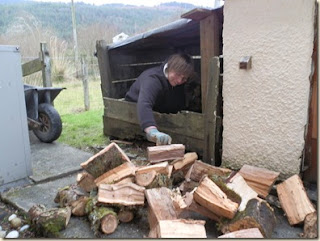The other morning I arose early to try to bag a nice sunrise photograph. What I had in mind was to catch the sun just as it rose above the Isle of Arran, which lies to the east of us. To start the project I put on generous layers of warm clothing then left the house in the cold half-light of the morning. Passing the village bakery at this time the nostrils are assaulted with one of the most enticing smells known to man, fresh bread straight from the oven, but I walked on by and turned up the lane to the golf course, immediately regretting not wearing wellington boots as rainwater squirted up from each step I took across the sodden grass. It was a fine morning but before I could get into a good position overlooking Kilbrannan Sound a dark cloud had raced overhead to spoil the sunrise. The photographic results were hardly worth the effort but in one of the shots I managed to capture Airds Castle, or what little remains of it, in the foreground. [Sadly this picture has since been lost so you will just have to take my word for it.]
As I studied this from my viewpoint on the edge of the rain-drenched golf course I tried to imagine the role this place had played in this landscape. A river of ice had once scraped out the 100 metre deep chasm lying before me and as the glacier receded there would have been a terrific ice cliff here at which the waves nibbled away until eventually every drop had floated away. The sea level would then have been higher than today (there is a line of old cliffs all around the area as evidence of this) but over time this changed, the land itself rising higher to form a new shoreline. Then at some point humans began to settle here, one of whom spotted the craggy outcrop overlooking the water and saw it as a defensible position, from what, nobody knows. After the immensely powerful natural forces that had shaped everything around me, man’s impact here seems very small.
Back home again and the list of different creatures entering our back garden continues to rise. Two rabbits come through from the back now to nibble at some of the more succulent grasses, generally keeping pace with any winter growth, although it has to be said they they seem to prefer next door’s slightly longer herbage to our sodden greenery.
We are delighted to learn that our youngest son Ben, having just returned from a musical trip to New York, is at last achieving some success and recognition in the world of music, such that we are beginning to lose count of the number of bands he now plays with. Over the next few months almost anyone living in Britain will have an opportunity to see and hear one of them, The Albion Band, in concert, as they are on a huge nationwide tour. We’ll be off to Edinburgh in March to see them.



No comments:
Post a Comment